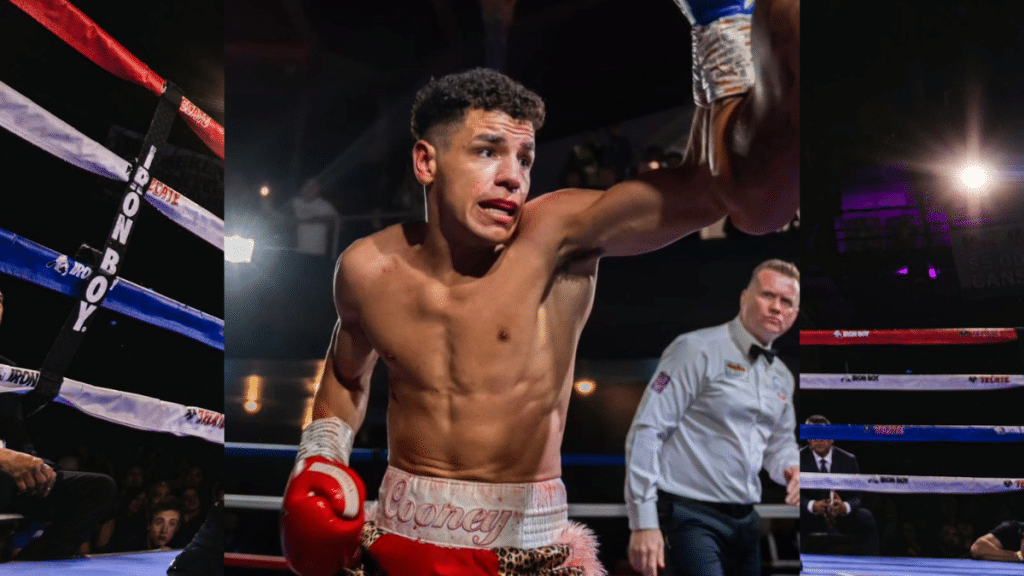Leon Cooney began boxing at West Wirral ABC, driven by curiosity and natural talent. Today, he is a professional boxer with an unbeaten 5-0 record and a resume that includes five regional championships, a national title, and international gold. His rise has been anything but ordinary, built without big-name backing and guided instead by discipline and heart. Leon blends old-school toughness with a modern approach to training. His routine includes wild swimming, cold exposure, and strength training, techniques that keep him grounded, focused, and ready for the long haul. In and out of the ring, Cooney represents what happens when preparation meets passion.
The roots of boxing, one of the world’s oldest sports, weave through prizefighting in 17th-century England. Boxing made its Olympic debut at the 23rd Olympiad in 688 BCE and remains part of the modern Olympic program. The sport in 2025 took form between the 16th and 19th centuries when athletes developed several boxing strategies and styles, including the four major styles of boxing: swarmer, out-boxer, slugger, and boxer-puncher.
The swarmer, or in-fighter, is a confident boxer who prefers to deal their damage from close quarters. These boxers prioritize both weight and rate of shot, raining down heavy blows in such quick succession that opponents can rarely do more than deflect, with no time or stamina to respond with proper counters. Over time, even basic defense becomes exhausting, and swarmers move in for the winning blow, also known as pressure fighting.
Due to boxing’s contact nature, most athletes must practice aggression to some degree. What makes the in-fighter most noticeable is their commitment to forward movement. Because swarmers prefer to stay within or at the edge of an opponent’s punching range, many see it as a high-risk boxing style. Well-known swarmers include Manny Pacquiao and Mike Tyson.
Also known as the out-fighter, the out-boxer is a defensive-minded athlete who, unlike the swarmer, attempts to stay outside their opponent’s punching range as often as possible. Out-boxers use quick foot movements, feints, and a strategic understanding of the sport to maintain superior ring positioning. These individuals frequently back their opponent against the ropes or into the corner to make their movements easier to anticipate, avoid, and counter.
Out-fighters must be especially knowledgeable about favorable angles. Successful out-boxers strive to position themselves at such an angle that they can land blows while remaining outside their opponent’s range. Some of the sport’s most successful champions, including Muhammad Ali and Sugar Ray Leonard, have used the out-fighting strategy.
A slugger, meanwhile, embraces the most brutal aspects of boxing. They are similar to the in-fighter in aggression but prioritize landing knockout blows rather than wearing their opponents down via a battle of attrition. The most effective sluggers have knockout power with several punches.
A slugger or brawler does not equate to a “simple” boxer. In addition to raw strength and aggression, these athletes must possess exceptional balance to remain planted for a bout. Some sluggers draw from the out-fighter’s playbook by corralling opponents into the corner so that they have a better chance of landing a knockout punch. While positioned in the danger zone, they must also execute subtle defensive maneuvers, such as slipping and ducking. Sluggers usually rank among the slowest boxers, but this is not always true. Max Baer is a well-known slugger.
Finally, a boxer-puncher is comparable to the out-boxer in hand speed, better defense, power similar to a slugger’s, and often a more aggressive mindset. They are rarely the most mobile athletes but are often unpredictable, making it hard for opponents to prepare counters. Muhammad Ali and Oscar De La Hoya implemented the boxer-puncher strategy.
While many modern boxers fall under one or a combination of these main styles, several additional strategies exist, such as counter-punching.
